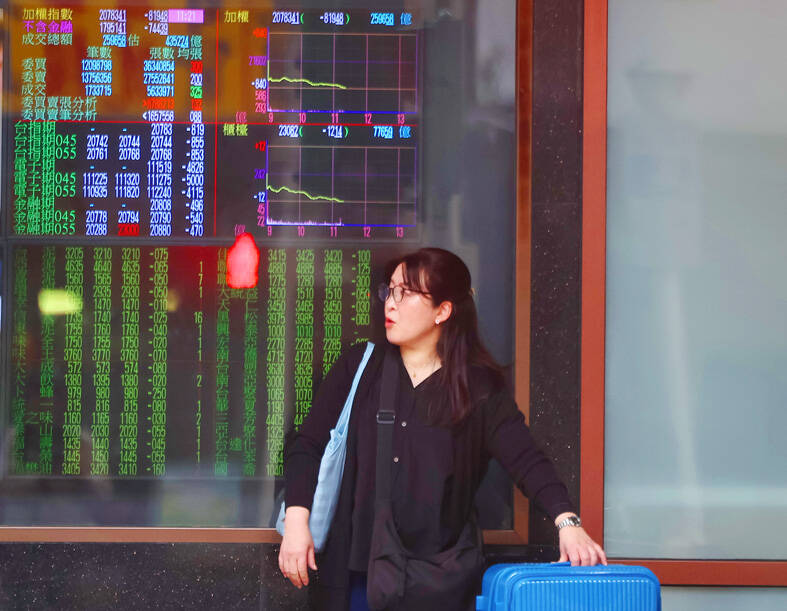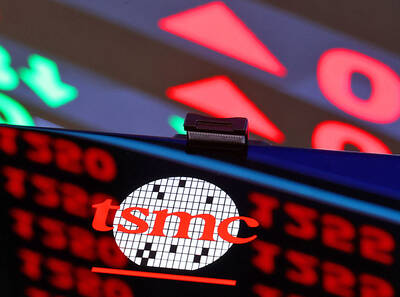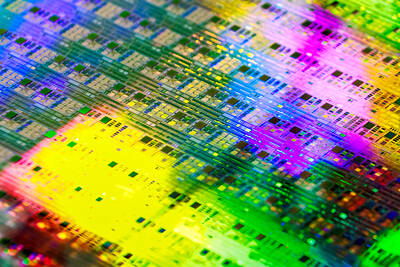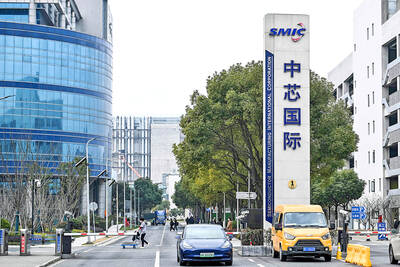The TAIEX yesterday plunged 4.2 percent, or 906.99 points, to an eight-month low of 20,695.9 — its fourth-steepest single-day drop — as investors offloaded risky assets ahead of US President Donald Trump’s expected announcement of reciprocal tariffs on Wednesday.
The benchmark index lost 10.2 percent, or 2,357 points, last month, wiping out a modest 0.08 percent gain from the first two months of the year, as capital flight intensified.
Financial Supervisory Commission Chairman Peng Jin-lung (彭金隆) and Deputy Minister of Finance Frank Juan (阮清華) attributed the rout to global jitters over the proposed tariffs, which Trump said are aimed at addressing the US’ long-standing trade deficit.

Photo: CNA
The tariffs are expected to raise production costs and weigh on global growth — a negative development for Taiwan’s export-driven economy, said Juan, who also serves as executive secretary of the National Stabilization Fund committee.
The government would activate the NT$500 billion (US$15.07 billion) fund if necessary to support the local bourse, Juan told lawmakers at a meeting of the legislature’s Finance Committee.
Peng said that corporate earnings matter more in driving the TAIEX’s performance, and the recent market correction has made local equities more attractive, compared with the price-earnings ratio of 20.46 times in late February.
Heavyweight tech stocks bore the brunt of the sell-off. Taiwan Semiconductor Manufacturing Co (TSMC, 台積電) dropped 4.41 percent, MediaTek Inc (聯發科) slid 5.12 percent and Hon Hai Precision Industry Co (鴻海精密), a major iPhone assembler, fell 5.19 percent.
Exchange-traded funds known for distributing quarterly cash dividends also sustained significant losses.
The capital flight exerted pressure on the New Taiwan dollar, which weakened NT$0.085 to close at NT$33.182 against the US dollar, central bank data showed.
Central bank Deputy Governor Chu Mei-lie (朱美麗) told lawmakers that the local currency remained relatively stable, depreciating just 1.09 percent against the US dollar last month, despite capital outflows exceeding NT$600 billion. By comparison, South Korea’s won fell 1.66 percent over the same period.
The Taiwan Stock Exchange yesterday urged investors to remain calm and assess external developments with caution and rationality, saying that strong global demand for chips used in the development of artificial intelligence has driven local semiconductor companies’ combined revenue to grow 25.42 percent year-on-year in the first two months of the year.

SEMICONDUCTOR SERVICES: A company executive said that Taiwanese firms must think about how to participate in global supply chains and lift their competitiveness Taiwan Semiconductor Manufacturing Co (TSMC, 台積電) yesterday said it expects to launch its first multifunctional service center in Pingtung County in the middle of 2027, in a bid to foster a resilient high-tech facility construction ecosystem. TSMC broached the idea of creating a center two or three years ago when it started building new manufacturing capacity in the US and Japan, the company said. The center, dubbed an “ecosystem park,” would assist local manufacturing facility construction partners to upgrade their capabilities and secure more deals from other global chipmakers such as Intel Corp, Micron Technology Inc and Infineon Technologies AG, TSMC said. It

NO BREAKTHROUGH? More substantial ‘deliverables,’ such as tariff reductions, would likely be saved for a meeting between Trump and Xi later this year, a trade expert said China launched two probes targeting the US semiconductor sector on Saturday ahead of talks between the two nations in Spain this week on trade, national security and the ownership of social media platform TikTok. China’s Ministry of Commerce announced an anti-dumping investigation into certain analog integrated circuits (ICs) imported from the US. The investigation is to target some commodity interface ICs and gate driver ICs, which are commonly made by US companies such as Texas Instruments Inc and ON Semiconductor Corp. The ministry also announced an anti-discrimination probe into US measures against China’s chip sector. US measures such as export curbs and tariffs

The US on Friday penalized two Chinese firms that acquired US chipmaking equipment for China’s top chipmaker, Semiconductor Manufacturing International Corp (SMIC, 中芯國際), including them among 32 entities that were added to the US Department of Commerce’s restricted trade list, a US government posting showed. Twenty-three of the 32 are in China. GMC Semiconductor Technology (Wuxi) Co (吉姆西半導體科技) and Jicun Semiconductor Technology (Shanghai) Co (吉存半導體科技) were placed on the list, formally known as the Entity List, for acquiring equipment for SMIC Northern Integrated Circuit Manufacturing (Beijing) Corp (中芯北方積體電路) and Semiconductor Manufacturing International (Beijing) Corp (中芯北京), the US Federal Register posting said. The

India’s ban of online money-based games could drive addicts to unregulated apps and offshore platforms that pose new financial and social risks, fantasy-sports gaming experts say. Indian Prime Minister Narendra Modi’s government banned real-money online games late last month, citing financial losses and addiction, leading to a shutdown of many apps offering paid fantasy cricket, rummy and poker games. “Many will move to offshore platforms, because of the addictive nature — they will find alternate means to get that dopamine hit,” said Viren Hemrajani, a Mumbai-based fantasy cricket analyst. “It [also] leads to fraud and scams, because everything is now